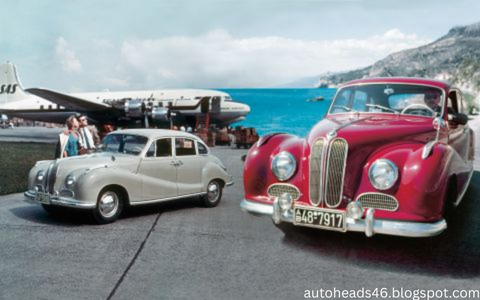History Of BMW And Its Global Success
The History of BMW: How a Small German Automaker
Conquered the World
You’ve probably heard of BMW, but
you might not know much about the company or how it became the global
powerhouse that it is today. Here’s an overview of how BMW’s brand identity
came about and achieved such a strong foothold in world markets to become one
of the most successful automakers in history. From humble beginnings to
worldwide success, here’s the record of BMW and its global success.
A Brief History of BMW
The Bavarian Motor Works, or BMW as
it’s more commonly known, is a car manufacturer founded in 1916. Initially
created to produce aircraft engines for WWI, it moved into automobiles in 1928
and had its first motorcycles in 1923. After surviving WWII and rebuilding in
both Germany and North America, it began selling cars worldwide. Today, its largest
markets are China, the USA, and the UK, while it exports to over 170 countries.
Its best-known models include iconic sports cars like the M3, Z4, and M5;
however, it also produces popular luxury saloons such as the 7 Series and X1.
In 2013, it became part of an
alliance with Brilliance Auto Group, which will see it sell vehicles under a
new brand called Brilliance BMW. In 2016, BMW sold 2.247 million vehicles
globally—more than any other premium brand—and has ambitious plans to double
sales by 2020. By 2025, BMW hopes to sell 5 million cars across 150 countries.
As well as being one of Europe’s most successful brands, it offers many
high-paying jobs worldwide. For example, assembly line workers at its
Spartanburg plant in South Carolina can earn $25 per hour—almost three times
what they would make doing similar work elsewhere in South Carolina (around $9/hr).
BMW currently employs 85,000 people around the world.
From 1908
to 1945
Ups and downs marked the first
decades of BMW’s history. Its earliest models and motorcycles were far ahead of
their time in terms of quality and engineering, but Germany’s defeat in WWII
forced it to re-start from scratch. (Read more about how it all began.) From
1945 to 1973: A four-year hiatus during World War II didn’t stop BMW production
entirely—it just meant that bikes were made for practical purposes rather than
fun. When the war ended, however, fun was exactly what they started making
again! (Read more about how things went after WWII.) From 1973 to the Present
Day: With its new bike series introduced in 1973—the R100RS—BMW could firmly
establish itself as an icon of style and performance once again. Today, it
continues to build on that legacy with cutting-edge technology and sleek
styling. (Read more about how BMW got where it is today.)
From 1990 to Today
The 1990s were a good decade for
BMW. In 1992, for example, more than 1 million cars were built and sold. In
1994, Daimler-Benz (the maker of Mercedes-Benz) became its largest shareholder.
That same year marked the debut of what would become one of BMW’s most popular
vehicles, introduced in 1996: The Z3 roadster. Then came 1998, when BMW
established an American subsidiary to produce luxury cars at a plant near
Spartanburg, South Carolina. Since then, U.S.-made models have included not
only SUVs but also sedans like the 5 Series and 7 Series. Today’s lineup
includes other models, including electric vehicles such as i3 and i8, and sales
continue to climb steadily upward. By 2008, total worldwide production had
topped 2 million units per year. By 2011, it had passed 3 million; by 2012, it
was 4 million; by 2013, it was nearly 4.5 million. And by 2014? It was over 5
million—and counting.
Modern-Day BMW - A Rising Star
A man named Franz Josef Popp was
looking for someone to help build a car and found it in Karl Rapp. Together,
they would form the Rapp Motor Company in 1917. A year later, Rapp moved on
from Rapp Motor Company to found Dixi with some investors. It wasn’t until 1922
that Dixi Motors renamed itself Bayerische Motoren Werke (Bavarian Motor
Works).
This was when its logo began
featuring an airplane propeller and wings. The company struggled through much
of its early history, but things changed after World War II. In 1949, BMW
became part of Auto Union, including Audi and DKW. But less than ten years
later, in 1952, Auto Union broke apart into three separate companies again—BMW
being one of them. The first real success came in 1959 when BMW introduced
their new 1500 model series, which sold over 250,000 units by 1962; a
considerable number for such a small company then! And since then, BMW has been
growing steadily. They acquired Rolls-Royce Motor Cars Limited in 1998,
launched Mini Cooper cars in 2001, and acquired Husqvarna Vapenfabriks AB
(motorcycles) in 2007. They are currently working on electric vehicles and have
plans to create self-driving cars! And who knows what else they might do next?
What’s Next for BMW?
In late November, CEO Norbert
Reithofer announced he would step down in 2015, having been with BMW since
1980. The announcement came just months after Peter Schwarzenbauer—BMW’s
current head of sales and marketing—announced his plans to retire over the next
three years. At that time, Reithofer said Schwarzenbauer’s successor had not
yet been identified. While no replacement has been named, several internal
candidates could be tapped for one of these top positions. These include Harald
Krüger, who heads up production; Klaus Froehlich, who heads up research and
development; and Herbert Diess, who runs BMW’s Mini brand. All have risen
through the ranks at BMW to hold senior leadership positions. Another name
being floated is Ian Robertson, who currently leads BMW’s global sales and
marketing team. Robertson is British but was previously vice president of operations
for China and served as general manager of Rolls-Royce Motor Cars Asia Pacific
before taking on his current role in 2013. Whoever fills those roles will face
challenges different from those faced by their predecessors.
Conclusion
The success of BMW can be traced
back to its early days when founder Franz Josef Popp and designer Karl Rapp
created an elegant 2-cylinder motorcycle that could conquer any road. Since
then, the company has produced some of the world’s most recognizable cars—the
3-Series sedan has earned more than 5 million sales since 1975 and remains one
of Germany’s top luxury automobiles. Today, under new CEO Harald Krueger, BMW
is as innovative as ever. Thanks for reading this article. Feel free to contact
me if you have any queries.
Also Read About This
https://autoheads46.blogspot.com/2022/10/history-of-volkswagen-and-its-splendid.html
https://autoheads46.blogspot.com/2022/10/toyota-prius-2022-price-features-and.html




.png)

.png)

.png)
.png)

0 Comments